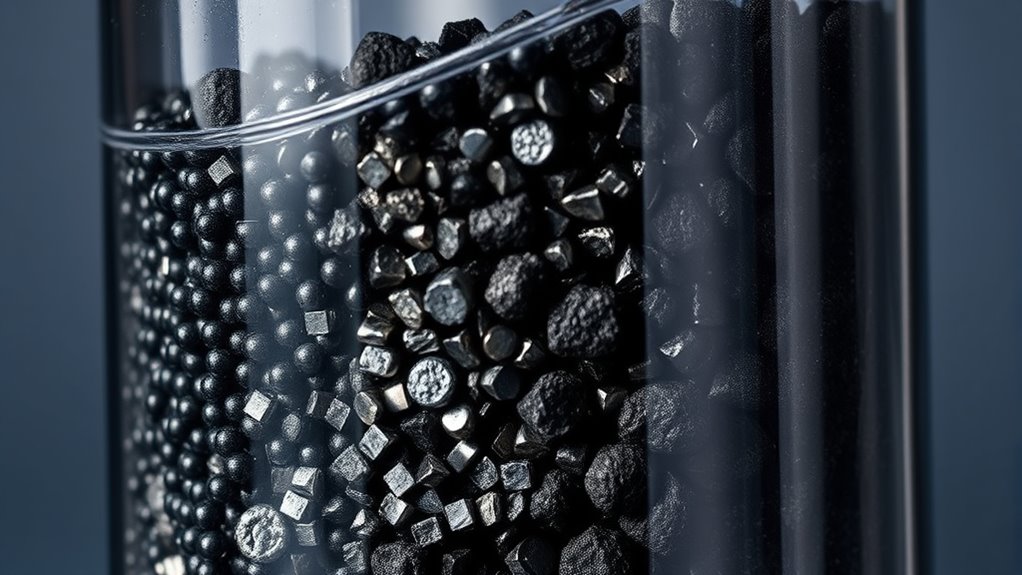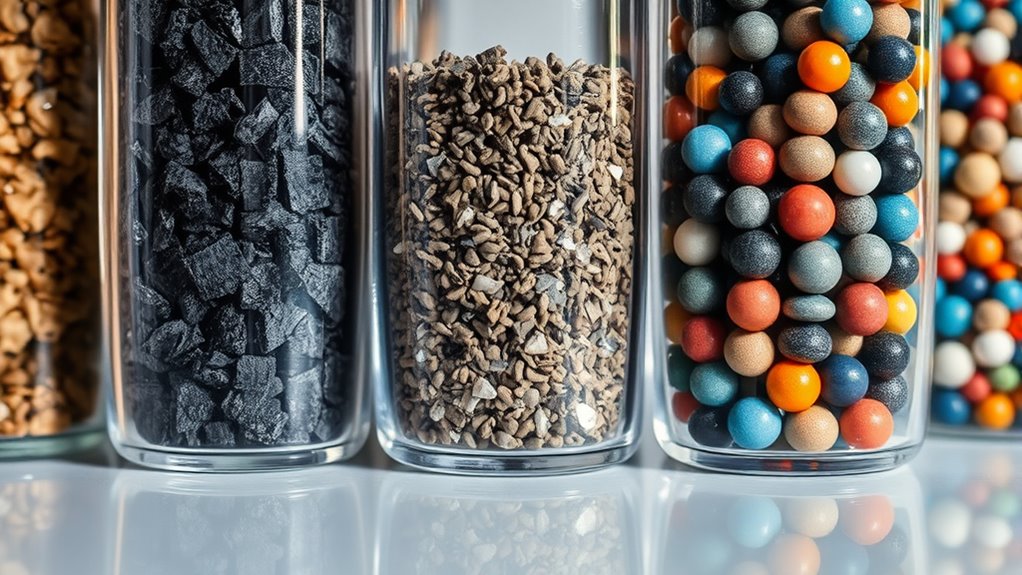When choosing filter media like carbon, KDF, or catalytic carbon, consider your water quality issues and maintenance needs. Carbon filters excel at removing chlorine, taste, and odors, while KDF targets heavy metals and bacteria. Catalytic carbon handles chloramine and organics better. Think about how often you’ll need to replace the media and your budget. If you keep these factors in mind, you’ll select the best fit for clean, safe water. More tips await you ahead.
Key Takeaways
- Assess water quality issues to select media that effectively target contaminants like chlorine, heavy metals, or organics.
- Consider media lifespan and maintenance frequency to balance upfront costs with long-term performance.
- Match media compatibility with existing or planned filtration systems for easy installation and retrofit options.
- Understand each media’s properties—e.g., carbon for taste and odor, KDF for heavy metals, catalytic carbon for chloramine.
- Prioritize safety and ease of maintenance to ensure reliable filtration performance and system longevity.

Selecting the right filter media is a crucial step in guaranteeing your filtration system works effectively. When choosing between options like carbon, KDF, catalytic carbon, and others, you need to reflect on how each fits into your system’s installation options and maintenance requirements. Different media have unique properties, so understanding these factors helps you make an informed decision that keeps your water clean and your system running smoothly. For example, considering safety and maintenance aspects ensures that your chosen media will perform reliably over time.
Carbon filters are one of the most common choices because they excel at removing chlorine, volatile organic compounds (VOCs), and bad tastes or odors. They’re versatile and readily available, making installation straightforward in most systems. However, their maintenance requirements are relatively simple but essential: they need regular replacement, typically every 6 to 12 months, depending on water usage and quality. This replacement ensures the filter remains effective and prevents bacteria buildup. When contemplating installation options, carbon filters are usually compatible with various housing units, so you can easily retrofit or upgrade existing systems without major modifications.
KDF media, on the other hand, is excellent for reducing heavy metals like lead and mercury, as well as controlling bacterial growth. It’s often used in combination with other media to extend their lifespan and enhance filtration performance. KDF media can be added to your existing filter setup with minimal effort, thanks to its flexible installation options. For maintenance, KDF media generally lasts longer than carbon, sometimes up to two years, but it still requires periodic inspection. You’ll want to check it regularly for any signs of clogging or reduced flow, which indicates it’s time for replacement or regeneration.
Catalytic carbon offers advanced removal capabilities, especially for chloramine and certain organic chemicals that regular carbon filters might struggle with. Its installation options are similar to traditional carbon filters, fitting into standard filter housings. Maintenance requirements are slightly more involved, as catalytic carbon typically needs to be replaced more frequently—every six months—to maintain optimal performance. If you’re aiming for a high level of purification, catalytic carbon is worth the extra attention, but you’ll need to stay on top of its replacement schedule.
Ultimately, your choice depends on your specific water quality issues and system setup. Some media require more frequent attention, while others last longer but may come at a higher initial cost. Considering installation options and maintenance requirements upfront helps you avoid costly mistakes and ensures your filtration system delivers clean, safe water consistently. By matching the right media to your needs, you’ll maximize filtration efficiency and extend the lifespan of your system.
Frequently Asked Questions
How Long Does Filter Media Typically Last Before Replacement?
Typically, your filter media lasts about 6 to 12 months before needing replacement, depending on usage and water quality. You should monitor the media lifespan and replacement frequency to guarantee ideal filtration. Regularly check for signs of media saturation, like reduced water flow or taste changes. Replacing your filter media on schedule helps maintain water quality and prevents buildup that can compromise your system’s effectiveness.
Can Multiple Filter Media Types Be Combined Effectively?
Yes, you can combine multiple filter media types effectively through media layering, which enhances filtration and extends filter life. Make certain media compatibility so each layer works synergistically without interfering with the others. By strategically layering media like carbon and KDF, you optimize contaminant removal, improve water quality, and maximize system efficiency. Always follow manufacturer guidelines to prevent clogging or media reactions that could compromise your filter’s performance.
Are There Specific Contaminants Each Media Type Targets Best?
Yes, each media type has specific contaminant targets that shape its effectiveness. For example, activated carbon excels at removing chlorine, odors, and organic compounds, showcasing its contaminant specificity. KDF media is best for heavy metals and bacteria, while catalytic carbon targets chloramines and certain chemical contaminants. Understanding these differences helps you select the most effective media for your water treatment needs, ensuring maximum contaminant removal based on each media’s effectiveness.
What Environmental Factors Influence Filter Media Performance?
Ironically, your filter’s performance hinges on the very environment it’s meant to purify. You should watch the pH level and water temperature, as they directly impact how well media like carbon or KDF work. If water’s too hot or too acidic, contaminants slip through. Keep these factors in check, and your filter will perform at its best, turning a messy water problem into a clear solution.
How Do Costs Compare Among Different Filter Media Options?
You’ll find that cost comparison varies considerably among filter media options. KDF and catalytic carbon tend to be more affordable upfront, making them good choices for budget-conscious setups. Activated carbon often costs less initially but may require more frequent replacement. An affordability analysis helps you weigh long-term expenses versus initial costs, ensuring you choose a media that fits your budget while meeting your water quality needs efficiently.
Conclusion
Remember, you’re only as good as your filter media choice. Whether it’s carbon, KDF, or catalytic carbon, pick what suits your needs best. Do your research, weigh the pros and cons, and don’t rush the decision—quality water depends on it. As the saying goes, “A chain is only as strong as its weakest link,” so invest wisely in the right media to keep your water pure and safe.









